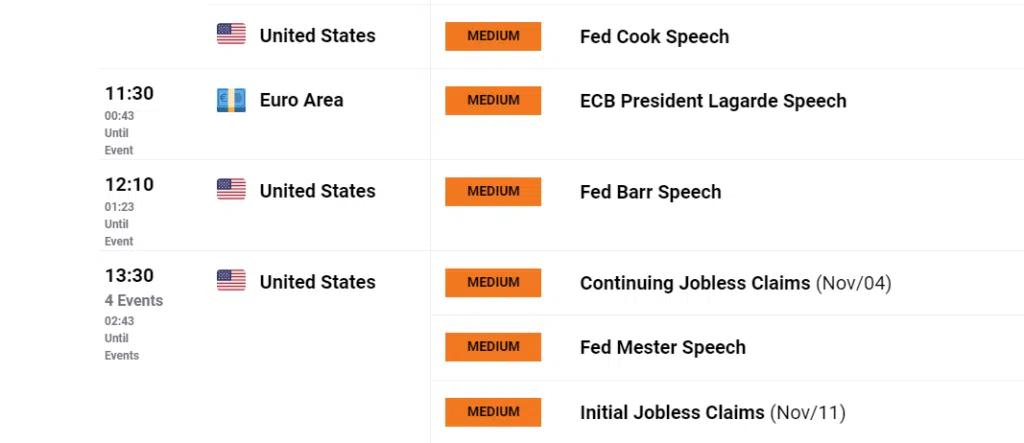-
Best Forex Brokers
Our top-rated Forex brokers
-
NGN Trading Accounts
Save on conversion fees
-
Brokers for Beginners
Start trading here
-
Forex Demo Accounts
Learn to trade with no risk
-
ECN Brokers
Trade with Direct Market Access
-
No-Deposit Bonuses
Live trading with no deposit
-
High Leverage Brokers
Extend your buying power
-
Lowest Spreads Brokers
Tight spreads and low commissions
-
Islamic Account Brokers
Best accounts for Muslim traders
-
Market Maker Brokers
Fixed spreads & instant execution
-
MetaTrader 4 Brokers
The top MT4 brokers in Nigeria
-
MetaTrader 5 Brokers
The top MT5 brokers in Nigeria
-
TradingView Brokers
The top TradingView brokers
-
cTrader Brokers
The top cTrader brokers in Nigeria
-
Forex Trading Apps
Trade on the go from your phone
-
Copy Trading Brokers
Copy professional traders
-
All Trading Platforms
Find a platform that works for you
On Tuesday, 14th November, lower-than-expected inflation (CPI) numbers sent the USD, as represented by the DXY index, into a tailspin – falling over 1.5% over the course of the day. While the flat month-on-month CPI print was only a minor change from the forecast 0.1% increase, it was the trigger for a seismic shift across all financial markets. Equities and commodities rallied, bonds surged, and in the Forex market, the EUR and the GBP hit multi-week highs against the dollar.
So, if the difference between the actual CPI and the forecast was so small, what caused these huge market moves? Well, despite continued hawkish rhetoric from members of the Federal Reserve, the markets have finally concluded that the Fed has done enough to contain inflation. Market expectations are now that the next move the FOMC will make with interest rates will be downward, even if that won’t happen for a few months.
Strong US retail sales data on Wednesday, 15th November didn’t alter the mood much, and with producer inflation (PPI) coming in negative at -0.5% vs a forecast increase of 0.1%, market expectations of an end to the rate hikes were reinforced.
The DXY has recovered somewhat from the battering it took on Tuesday but will remain vulnerable for the foreseeable future, as interest rate expectations are basically nil. Since its spectacular rally on Tuesday, the EUR/USD has been trading in a range around the 1.085 mark, with ING analysts saying that “we currently forecast EUR/USD staying quite steady – not far from current levels – into year-end.”
While that may be the case, Thursday 16th and Friday 17th November brings a slew of central bank communication for traders to ponder.

Fed policymakers due to make speeches or statements include Michael Barr, Loretta Mester, John Williams, and Lisa Cook. European Central Bank (ECB) President Christine Lagarde will deliver opening remarks at the Annual European Systemic Risk Board Online Conference and give the keynote speech at the Frankfurt European Banking Congress. We will also hear from Megan Greene, Monetary Policy Committee member at the Bank of England.
Complex Central Bank Communication and Volatility
With this deluge of communications due over the next two days, it’s important for Forex traders to understand the effect of policymaker statements on the markets.
In a recent article for the Financial Times, Jumana Saleheen, Chief Economist at Vanguard Asset Management, discussed a paper she co-authored titled Keep it Simple: Central Bank Communication and Asset Prices.
Saleheen and her colleagues studied communication from the Bank of England’s Monetary Policy Committee (MPC) from 1999-2023, including speeches and statements from committee members.
Their research yielded two fascinating discoveries, Saleheen explains:
“We find that asset prices respond differently to how new information about the future path of policy is transmitted. Speeches by Monetary Policy Committee members are more potent in influencing medium to long run gilt yields than interest rate announcements and press conferences…. Measuring good communication is not easy. But complex communication tends to be followed by greater asset price volatility, which is undesirable from a macroeconomic perspective.”
So, not only do speeches by policymakers have more influence over asset prices than pre-organised statements (something that most traders already knew), but the more complex the language used in these speeches and statements, the more volatile the resulting price movements.
Saleheen and her colleagues argue that “central banks that want to avoid generating volatility in financial markets should keep it simple. Our results suggest that by ignoring the type and style of monetary policy communication, the previous literature has disregarded an important source of variation in asset prices.”.
To her credit, Saleheen does point out that complex communication is often unavoidable: “…when the economy was hit by shocks, like the pandemic and war in Ukraine, central banks had to work with new concepts and data to determine the best course for policy. Based on language structure and words, we find Bank of England communication has become more complex over time, as the environment has become more challenging.”
So, what does this mean for Forex traders? Well, on a day like today, when numerous statements are being made by policymakers during a challenging time, it’s worth keeping an eye on the complexity and ambiguity of the comments being made, as this may give you some idea of the volatility that will follow.
With the USD under constant pressure, and eurozone inflation numbers and more speeches due tomorrow, it’s worth donning a tin hat and preparing for a volatile 48 hours.
































